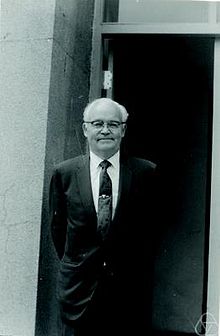Magnus Hestenes
This article needs additional citations for verification. (August 2013) |
Magnus Hestenes | |
|---|---|
 | |
| Born | February 13, 1906 |
| Died | May 31, 1991 (aged 85) |
| Nationality | American |
| Alma mater | University of Chicago |
| Scientific career | |
| Fields | Mathematics |
| Institutions | University of California, Los Angeles |
| Doctoral advisor | Gilbert Bliss |
| Doctoral students | Glen Culler William Karush Richard Tapia Jesse Wilkins, Jr. |
Magnus Rudolph Hestenes (February 13, 1906 – May 31, 1991) was an American mathematician. Together with Cornelius Lanczos and Eduard Stiefel, he invented the conjugate gradient method.
Biography
Born in Bricelyn, Minnesota, Hestenes earned his Ph.D. at the University of Chicago in 1932 under Gilbert Bliss. His dissertation was titled "Sufficient Conditions for the General Problem of Mayer with Variable End-Points." After teaching as an associate professor at Chicago, in 1947 he moved to a professorship at UCLA. He continued there until his retirement in 1973, and during that time he served as department chair from 1950-58. While a professor, Hestenes supervised the thesis research of 34 students, among them Glen Culler, Richard Tapia and Jesse Wilkins, Jr..
Hestenes received the Guggenheim (1954) and Fulbright awards, was a vice president of the American Mathematical Society, and was an invited speaker at the 1954 International Congress of Mathematicians in Amsterdam.
He died on May 31, 1991 in Los Angeles, California.
External links
- Magnus Hestenes at the Mathematics Genealogy Project
- Obituary in the Numerical Analysis Digest
